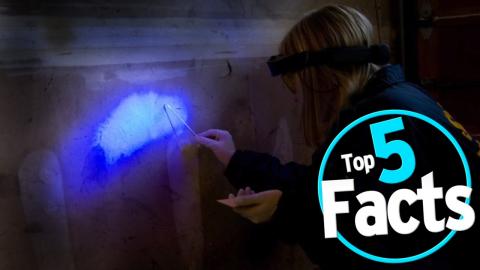Top 5 Facts About DNA Evidence

The genetic codes of DNA bind people together, but the hard facts can lead to a legal separation as well. Join http://www.WatchMojo.com for Top 5 Facts. In this installment, we're counting down our picks for the most interesting facts you probably didn't know about DNA evidence.
Special thanks to our user MikeyP for submitting the idea at WatchMojo.comsuggest
#5: DNA Was First Used for a Criminal Investigation in 1986
Before the mid-80s, both genetic fingerprinting and DNA profiling were theories rather than accepted legal practices. And due to the innovations of Professor Alec Jeffreys, DNA first assisted criminal prosecutors in 1986. After the rape and murder of two English women, Richard Buckland, a teenager with learning disabilities, became the prime suspect. But with Jeffreys’ discovery of how to separate sperm and vaginal cells, the evidence linked another man to the crimes. And so, after a long history of flashing women, it was revealed that Colin Pitchfork’s crimes had taken a more violent turn, which ultimately led to a life sentence in prison. By convicting Pitchfork and clearing Buckland of these crimes, this case was both the first exoneration and conviction via DNA fingerprinting.
#4: Thanks to TV, Jurors Expect DNA Evidence
Given the popularity of the “CSI” franchise and, earlier, the media circus that was the O.J. Simpson trial, DNA evidence has become a standard expectation for modern jurors. This expectation is part of what’s known as the “CSI Effect.” One of the largest studies on it found that 73% of prospective jurors expect to see DNA evidence presented in rape cases, while 22% expect to see it used in every criminal case. In other words, the general public now understands the power of DNA and the creative ways in which it can be acquired. Fans of crime procedurals may think they have a better understanding of how DNA works, but those shows are often criticized for being inaccurate in their science. So then the question becomes, does a juror’s perceived understanding of forensics have an impact on their decision making? Research on the topic seems to say, thankfully, that it does not.
#3: Police May Collect DNA Without Your Knowledge
While covert operations sometimes reveal police “entrapment,” American criminal investigators may legally collect DNA evidence without a subject’s knowledge. This might take the form of a police officer telling a detainee to spit out their gum, or innocently offering a glass of water, only to collect that gum or that drinking glass to obtain a DNA sample. In 1988 the Supreme Court of the US determined that evidence can be collected from garbage left on the curb in front of a home. Of course, cops don’t need to steal your used hankies to collect DNA. A 2013 Supreme Court ruling affirmed that U.S. police officers can collect a cheek swab from an arrestee just as they’d collect fingerprints. And over in the United Kingdom, investigators may also collect public samples, however private investigators may not legally employ such tactics due to The Human Tissue Act of 2004.
#2: It’s Possible to Have Two Sets of DNA
In the early stages of pregnancies, a fetus can be absorbed by its twin, which can occasionally lead to a second set of DNA being present within the surviving twin. Having two separate sets of DNA is called chimerism. Strangely enough, this means that paternity and maternity tests have yielded some inexplicable results, causing a bit of stress for those just learning of their unborn twin. For example, one chimera Lydia Fairchild nearly lost custody of her children after DNA tests indicated she was not their mother. In 2014, a 34-year-old Washington man also learned that he was, genetically, not the father of his own children given that he was carrying DNA of his unborn twin. And so, DNA evidence not only assists in real-life courtroom dramas but sometimes creates some unexpected family drama as well.
#1: A DNA Mistake Created a Fictitious Serial Killer
From 1993 to 2009, a female serial killer left DNA at murder scenes in Germany, Austria and France. This unidentified woman became known as “The Phantom of Heilbronn.” However, it turns out that she didn’t actually exist. The so-called “Woman Without a Face” was created due to contaminated cotton swabs. Apparently, all the law enforcement agencies involved had been ordering cotton swabs from the same factory, and apparently one of the female factory workers had gotten some of her DNA on them. And so the truth evaded the grieving families of these murder victims while investigators hunted down a fabricated serial killer, all because of one procedural error. One thing’s for sure, this never would have happened if European forensics experts watched more CSI.
So, do you think watching police procedurals has made you a better crime fighter? And do you know anyone that has been legally tormented by an unborn twin? For more incontrevertible top 10s and contaminated Top 5s, be sure to subscribe to WatchMojo.com
